This post may contain references or links to products from one or more partners of our parent company and/or subsidiaries of our parent company. For more information, visit this page.
December 14, 2021
What’s the best flooring for kitchens?
Tile and vinyl can’t be the only options, right? What about hardwood or laminate? Does the best kitchen flooring really have to be waterproof? Are there workarounds?
If you’re here, you have questions. And we have answers!
Below, we’ve put together a comprehensive guide on the best flooring for kitchens, including a quick summary of different features to check for, a full breakdown of 10 of our favorite kitchen flooring choices, and an FAQ section to cover any remaining details about choosing the best flooring for kitchens.
Let’s get started!
Or, if you prefer, click here to skip right to our 10 best kitchen flooring options list!
What to Look for in the Best Kitchen Flooring
Looking for great kitchen flooring is a lot like looking for the best flooring for dogs. You want it to be durable, easy to clean, and at least water-resistant (features that also make for great mudroom flooring).
Below, we’ve compiled the most important features to consider.
Durability Is Important…
Imagine dropping a cast iron pan on your kitchen flooring and it leaves a massive dent. If you’re an avid chef, these things happen—and you want durable flooring that can stand up to that beating.
Something like EVP flooring (an advanced form of LVP) is a good place to start, but we’ll get into all the best flooring options later.
Of course, durable flooring can be expensive, so it’s perfectly okay to sacrifice a little oomph to balance costs.
…But Water-Resistance Is a Must
Whereas you can compromise a tad on durability, water resistance is really important for kitchen flooring. Even the cleanest chef is going to have minor spills and splashes from time to time.
For this reason alone, you can probably rule out any type of carpet. Even water and stain-resistant options like Tigressa carpet or Lees carpet aren’t worth the risk.
Ideally, any floor you install in a kitchen should be water-resistant or waterproof. Moreover, it’s exceedingly important that the floor is installed correctly for liquid protection to work. That means using an underlayment for vinyl flooring (or any type of flooring, actually), ensuring there are no open seams, and that the floor is perfectly level (otherwise, liquids can pool in one area, hastening the damage).
Easy Cleaning and Maintenance Are Ideal
A clean kitchen is a safe kitchen.
The easier it is to clean your kitchen flooring, the better. Oils and other messes can make floors slick or sticky, increasing the risk of injury or disaster. So, the best flooring for a kitchen is one that’s super easy to clean and maintain.
Anything that requires a lot of work (even the best hardwood floors) may not be worth the time investment for all buyers.
Don’t Forget About Comfort!
Comfort is going to matter to people who often use their kitchen for cooking, especially around holidays or celebrations. Standing or pacing around super hard kitchen flooring for hours can absolutely wreck your joints and back. It’s a horrible feeling, and horrible for you—and if you’re not careful, it can lead to chronic pain and other health issues.
The best kitchen flooring is also going to be the one that’s best for you to, you know, cook on.
The Most Important Tip for Finding the Best Kitchen Flooring: Do You Embrace the Cooking Lifestyle?
Any time you’re exploring flooring ideas you should think long and hard about how you’re going to use the space. Naturally, the best flooring for a kitchen depends heavily on you.
If you’re a cooking fanatic (we speak the same language!), the factors above should be critical in your final decision. If your kitchen is more of a this-is-where-we-microwave-our-takeout spot (no judgment!), then you can probably get away with kitchen flooring that doesn’t emphasize the features above.
The Best Flooring for Kitchens: 10 Great Options
As you can imagine, there are many types of flooring that can be installed in a kitchen! Here’s a quick breakdown of our favorites.
Oh, and to be clear, we’re not necessarily ranking the options below, as each offers features that will appeal to different buyers.
Best Brands of 2024
#1. Luxury Vinyl Plank/Tile (LVP/LVT)
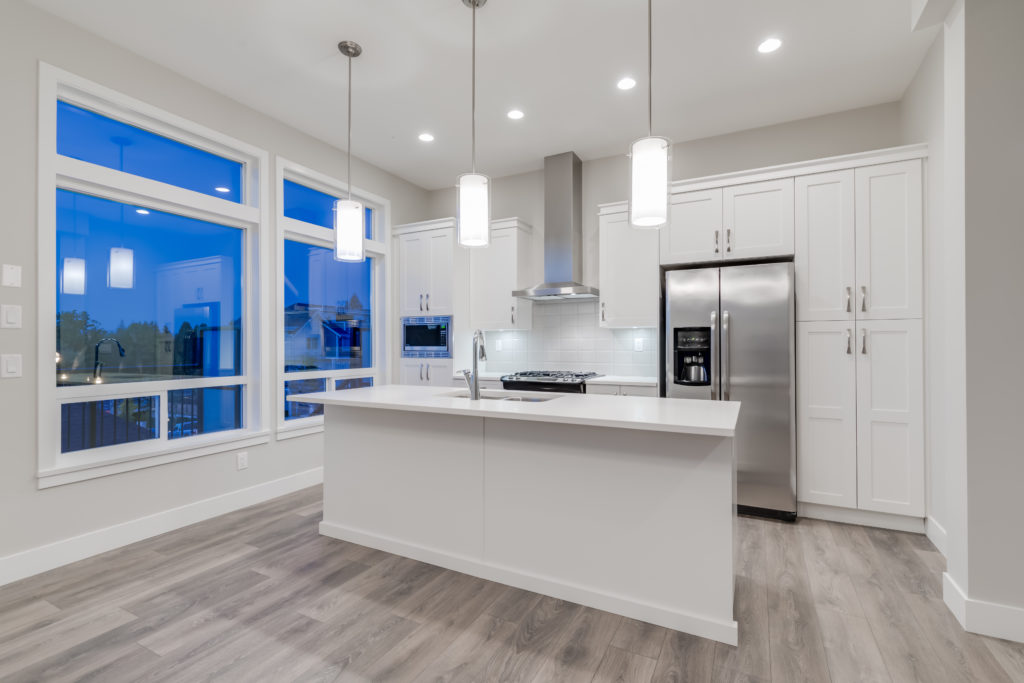
Luxury vinyl is a multilayered form of PVC flooring that’s incredibly durable, fully waterproof, and generally inexpensive to buy and install—especially compared to classic options like solid hardwood. It comes in both plank (LVP) and tile (LVT) forms, which offer convincing wood or stone looks, respectively.
Anyway, the best vinyl plank flooring is unbelievably versatile, so it can absolutely be installed as kitchen flooring.
Upgraded versions of LVP that use an enhanced core layer, usually called EVP or rigid core luxury vinyl flooring, are especially durable and should have no trouble standing up to daily wear and tear in a busy kitchen (check out our COREtec flooring reviews to see one option). However, even high-quality, flexible LVP like Karndean vinyl plank flooring can last for decades!
Note: for this article, it’s safe to assume that anytime we mention LVP we’re also talking about LVT.
Also: peel-and-stick vinyl plank flooring is commonly confused with LVP but they’re separate products. Peel-and-stick vinyl is generally less durable and usually intended as a temporary solution (i.e. it’s not ideal for long-term kitchen flooring).
Pros of Using Luxury Vinyl as Kitchen Flooring
LVP is an early contender for the best flooring for kitchen crown because it’s just so darn hardy.
The big draw: it’s completely waterproof and mimics hardwood very well (it’s a great way to get wood floor designs without worrying about spill damage). Plus, options like WPC flooring are incredibly comfortable too!
Also: the cost to install vinyl plank flooring really isn’t that bad compared to hardwood.
Cons of Using Luxury Vinyl as Kitchen Flooring
The only big disadvantages of vinyl plank flooring are that it’s not very eco-friendly (it’s plastic) and not all brands are created equal. There’s a lot of junk on the market, unfortunately. And brands like CoreLuxe don’t always have the best reputation (emissions scandals, bad warranties, etc.).
However, if you stick with the good brands you’ll have few if any problems with luxury vinyl tile or plank!
#2. Tile
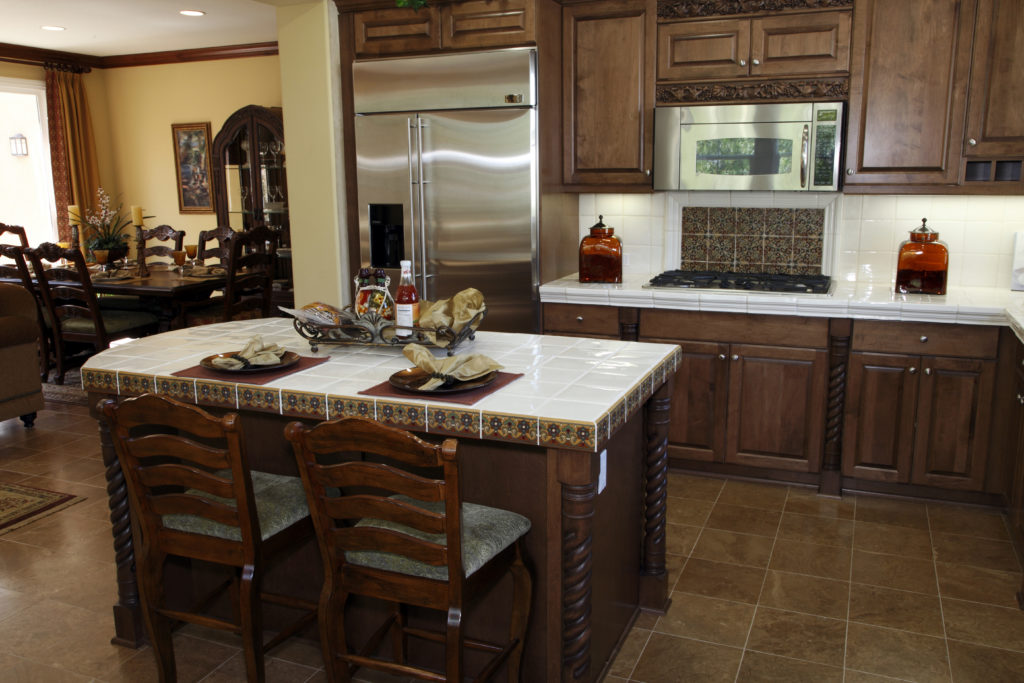
Like LVP, tile is versatile, durable, and fully waterproof. It’s been a staple of kitchen flooring for millennia, and for good reason.
Types of Tile Flooring
Most types of tile are made from ceramic, porcelain, or stone.
- Porcelain tile is made of refined clay which is fired in a kiln at an extremely high temperature—resulting in enhanced durability, minimal water absorption, and high stain resistance. It’s a great all-around choice for kitchen flooring that shouldn’t break your budget.
- Ceramic tile is made of less-refined clay than porcelain, which means it’s not as resistant to water and staining (which isn’t necessarily a problem)—but it also tends to be cheaper, more rustic, and more slip-proof.
- Natural stone tile can be made from a variety of materials like granite or limestone (on the cheaper side) and onyx or marble towards the higher end of the spectrum. The type of stone used to create the tile will determine its characteristics so there’s a lot of variation in terms of performance.
One more thing: you can also find plenty of wood-look tile products if you want the look and feel of hardwood but desire eco-friendly, easy-to-install, and less expensive kitchen flooring. It’s a great choice if you’re having a hard time choosing between tile vs. wood floors.
Pros of Using Tile as Kitchen Flooring
Porcelain, ceramic, and most types of stone tile are absolutely fantastic choices if you need scratch-resistant flooring. Beyond that, most tile flooring is hardy and resistant to everyday wear and tear—and best of all, it’s waterproof.
Tile flooring also tends to be eco-friendly, at least in the sense that it’s usually naturally sourced.
And if you want the easiest tile to install, you can’t go wrong with snap-together tile flooring!
Cons of Using Tile as Kitchen Flooring
On the downside, tile flooring repels water, which can make it slippery (especially slicker types like porcelain and polished stone).
It’s also pretty unforgiving on your joints and back, so if you’re one to run around your kitchen all day, you might want something a little softer.
Otherwise, tile is a great contender for the best flooring for kitchens.
#3. Engineered Hardwood
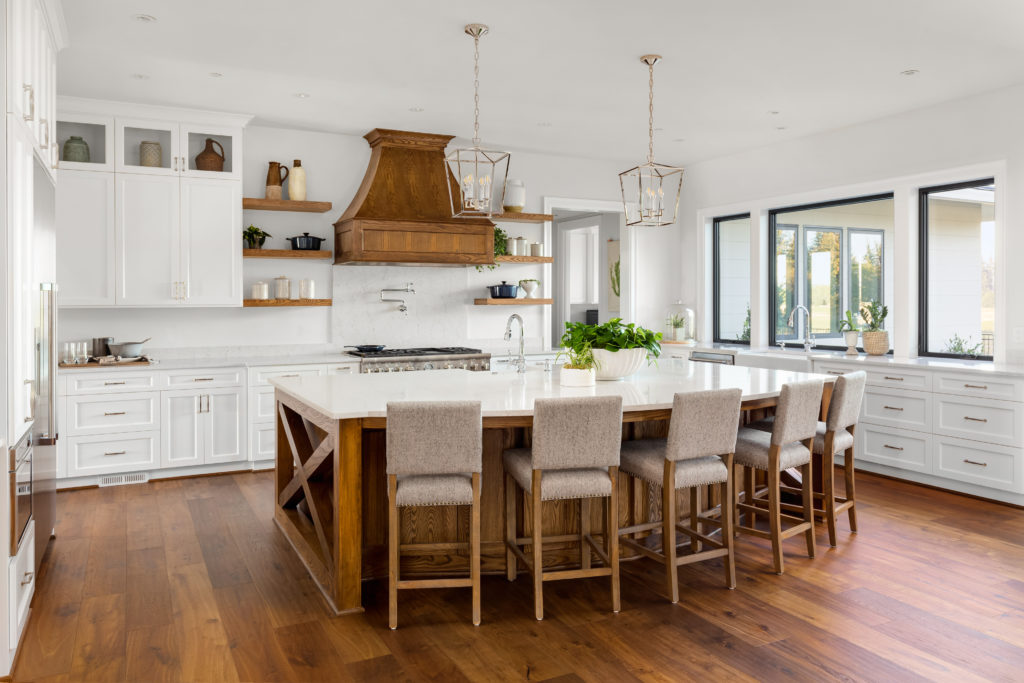
You might be surprised to see hardwood on this list because it’s not generally supposed to get wet—a quality that isn’t ideal for kitchen flooring, obviously. But as it turns out, engineered hardwood is a great kitchen flooring choice!
So what is engineered hardwood? Instead of using a solid plank of wood, engineered hardwood attaches a veneer of real hardwood to a slab of oriented strand board or plywood. This makes the product more dimensionally stable. Or in other words, it’s less prone to warping and cracking with environmental changes or spills. In fact, most types of waterproof hardwood flooring are engineered.
All that’s to say, the best engineered wood flooring can absolutely be installed in kitchens.
Pros of Using Engineered Hardwood as Kitchen Flooring
The best engineered wood flooring brands make products that resist water damage and environmental changes quite well. And since they’re made of real wood, these products aren’t lacking in authenticity (though we should note that most come as prefinished hardwood flooring, rather than finished-on-site planks).
Cons of Using Engineered Hardwood as Kitchen Flooring
There are only two major engineered wood disadvantages: 1) the cost of wood flooring is steep (including the cost to install engineered hardwood floors), and 2) even waterproof options can only survive liquid spills for so long.
If your kitchen flooring is going to take a messy beating, you’re going to have to subscribe to a rigorous maintenance schedule to preserve engineered wood floors.
#4. Laminate
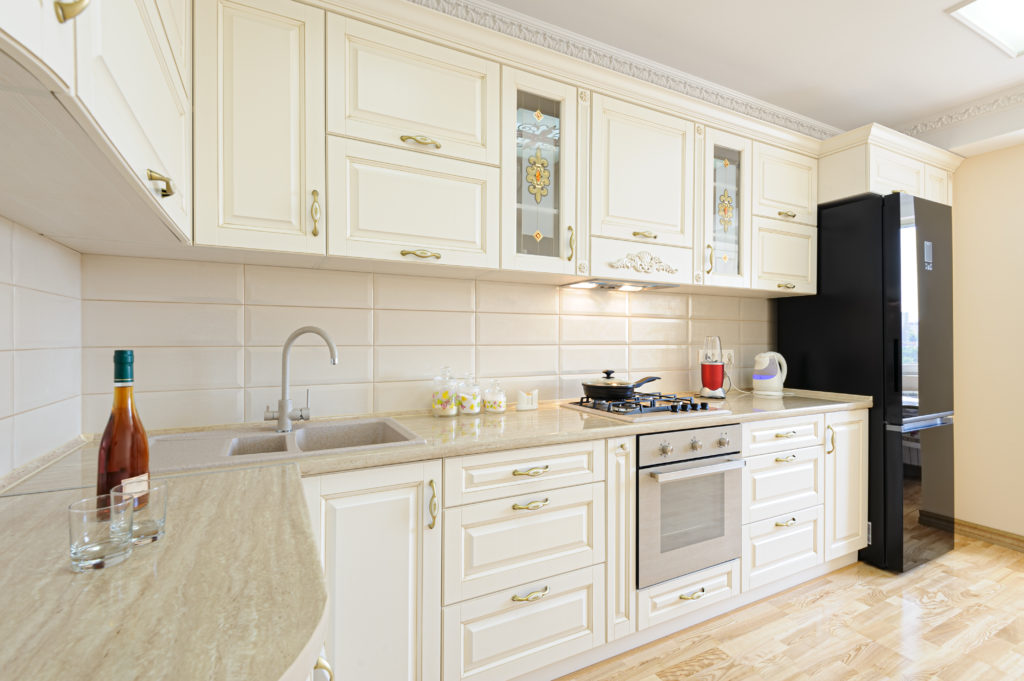
The best laminate flooring can be a great kitchen flooring choice if the right conditions are met. But what is laminate flooring? And why do people confuse laminate vs. engineered hardwood?
Well, like engineered hardwood, laminate uses a wood composite base (usually fiberboard, which is similar to plywood). But that’s about where the similarities end. It gets its photorealistic look from its image layer, which is protected by a durable wear layer.
Though it can technically be made to look like anything, laminate flooring is mostly sold as a less expensive substitute for hardwood flooring (you can read more about laminate vs. hardwood here).
For kitchen flooring, it’s absolutely critical that you choose water-resistant or waterproof laminate flooring (like AquaGuard laminate) because standard laminate products (like TrafficMaster laminate) will literally disintegrate with exposure to liquids.
Pros of Using Laminate as Kitchen Flooring
Products like Mohawk laminate flooring (especially the waterproof collections of RevWood) or Pergo TimberCraft are fantastic choices for kitchen flooring. They perform similarly to LVP and offer a wide range of styles to choose from.
The cost to install laminate flooring is often a fraction of what it costs to install real hardwood.
Plus, there are non-toxic laminate flooring options for those who are sensitive to harsh chemicals!
Cons of Using Laminate as Kitchen Flooring
There are also reasons to avoid installing laminate for kitchen flooring.
On the one hand, cheaper products like Armstrong laminate flooring or Costco laminate flooring have sketchy histories and mediocre reviews. On the other hand, fantastic choices like Shaw laminate flooring are as expensive as engineered or solid hardwood, but without the authenticity (or even true waterproofing).
All in all, the pros and cons of laminate flooring are a bit of a rollercoaster when it comes to kitchen flooring. Our take: certain products like RevWood are solid choices, but you should avoid anything that isn’t waterproof or water-resistant. Remember: the best kitchen flooring needs to be water-resistant!
#5. Sheet Vinyl
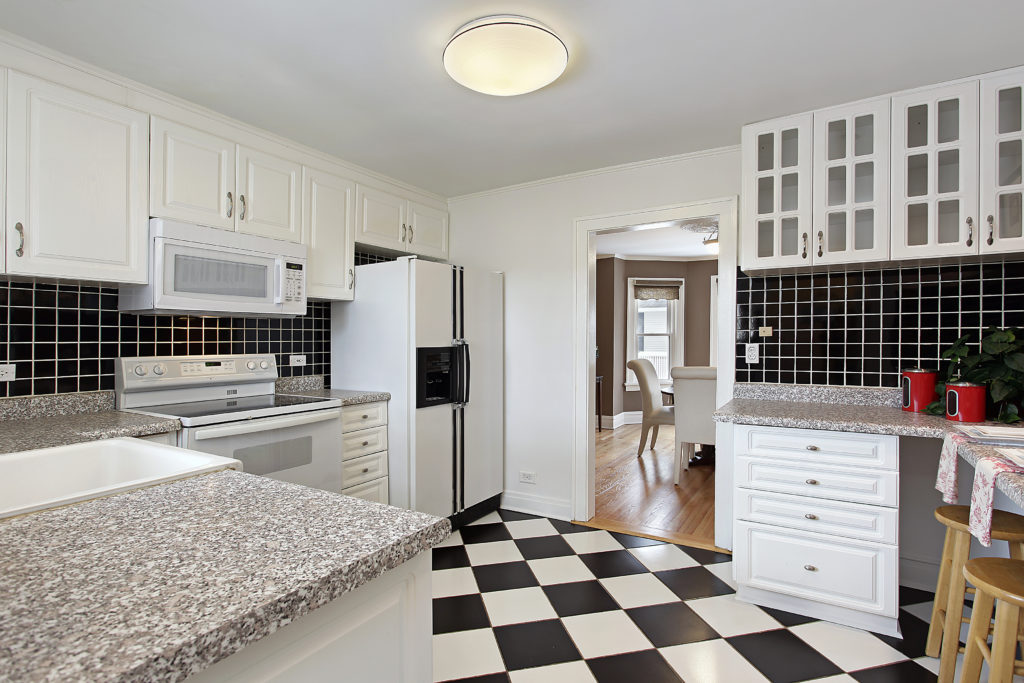
If you’re on a budget, sheet vinyl is one of the best kitchen flooring options that won’t break the bank.
As the original PVC flooring choice, single-layer sheet vinyl had its heyday back in the 1960s and ‘70s, but has survived through the invention of modern LVP to floor homes everywhere.
Like all waterproof vinyl flooring, sheet vinyl has no problems with liquids or (most) stains. And while it’s not nearly as durable as LVP, it’s significantly cheaper.
Pros of Using Sheet Vinyl as Kitchen Flooring
The best things going for sheet vinyl are its cost and its waterproofing. This flooring isn’t really intended to be flashy. There are some wood looks (we wouldn’t speak for their authenticity) but for the most part, sheet vinyl sticks to tile or geometric patterns. In other words, sheet vinyl is a great option for budget buyers who want decent kitchen flooring.
Cons of Using Sheet Vinyl as Kitchen Flooring
Even the best sheet vinyl flooring will probably only last a few decades or so. It’s durable enough to handle light traffic without issue but anything more will probably tear it up over time.
Sheet vinyl is also kind of hard to install without proper training. You have to cut it to size and carefully lay it down on your subflooring (what is subflooring?) so as to avoid any bubbles or wrinkles. Have you ever put a screen protector on a phone? It’s like that, but for your entire floor. Not fun.
Finally, sheet vinyl isn’t the best category to look for low-VOC vinyl flooring. Not so much because the vinyl itself is filled with VOCs (okay, that’s debatable too), but the adhesives required to glue sheet vinyl down might be.
#6. Concrete
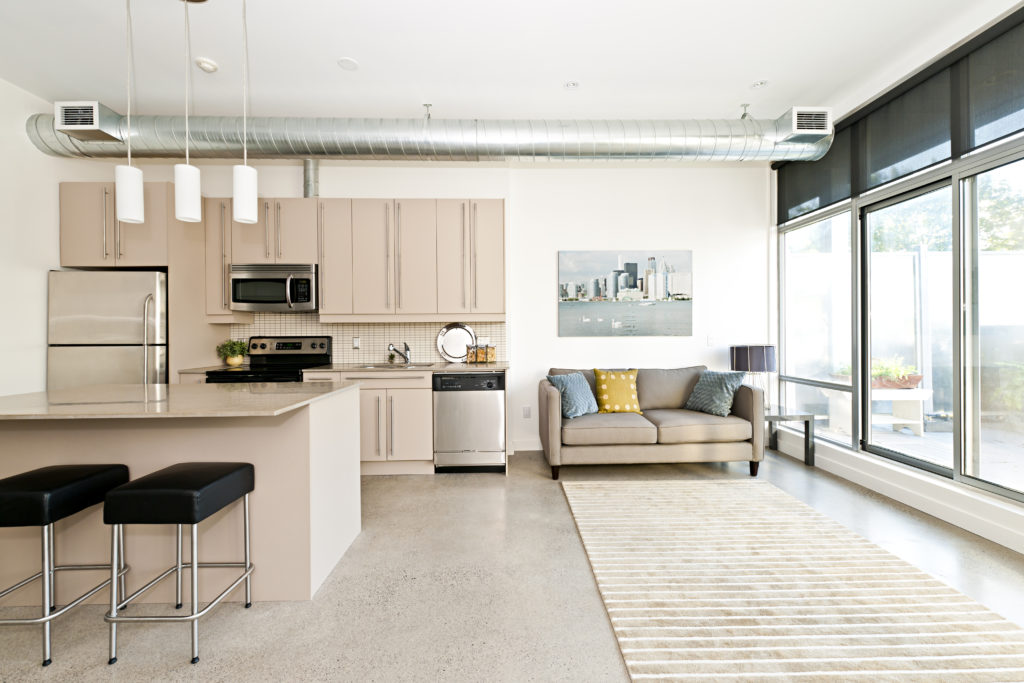
Concrete is a dark horse contender for the best flooring for kitchens (as well as the best flooring for basements) because it’s cheap, easy to clean, extremely durable, and waterproof.
You might be thinking, why would I want boring ol’ concrete in my home? Well…
Types of Concrete Flooring
You don’t have to keep your concrete kitchen flooring blank! You can paint it, stain it, polish it, and even texture it! Have you ever seen concrete flooring that looks like wood? It’s real!
To get concrete kitchen flooring, you simply pour it over your prepared subflooring, shaping it as you go. Once it’s dried, you can style it however you like.
Pros of Using Concrete as Kitchen Flooring
With some exceptions, concrete is fairly inexpensive to buy and install as kitchen flooring. More than that, it’s supremely durable and waterproof. Barring a shift in your foundation or some other disaster, concrete flooring can last indefinitely.
Cons of Using Concrete as Kitchen Flooring
The worst thing about concrete kitchen flooring: it’s not trying to pamper anyone. Seriously. Concrete flooring offers absolutely no comfort. So, it’s going to be tough on your feet, joints, and back.
Also, you can’t really go out and buy concrete flooring; you have to DIY it. Now, it doesn’t require that much skill, but if you’ve never worked with concrete before or don’t necessarily trust your creative skills, the trouble may not make up for the low cost.
Oh, and if it didn’t go without saying, you can’t really install concrete over a non-concrete subfloor.
#7. Cork
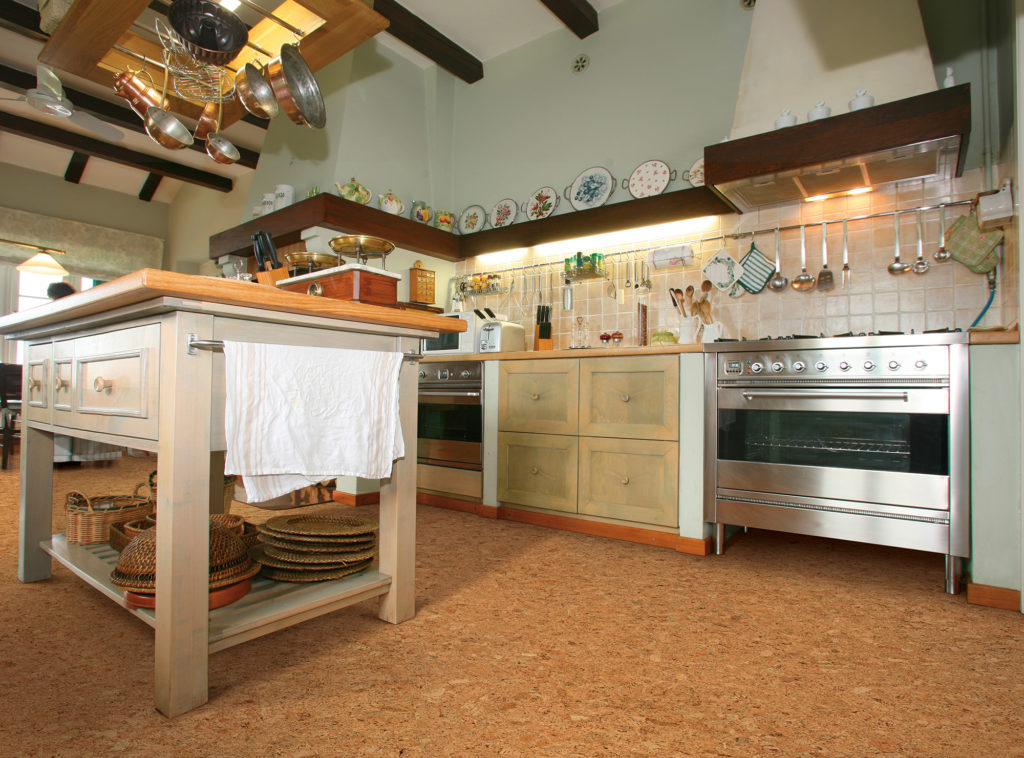
The pros and cons of cork flooring make it a worthy option for some kitchens. We’ll touch on this again momentarily, but first, let’s explain what it is!
Cork—yes, the very same material capping your wine bottles—is a natural, wood-like substance extracted from cork trees that’s commonly used for insulation and, ironically, underlayments for flooring.
When used for flooring, cork is ground up, boiled, and combined with natural resins before being shaped into tiles, sheets, or even planks that mimic the style of hardwood.
Pros of Using Cork as Kitchen Flooring
The best cork flooring is sustainably sourced and produced, which generally makes it eco-friendly flooring (though international shipping may bite into this).
Anyway, cork also has a nice springy feeling to it that’ll benefit anyone who runs marathons in their kitchen. Cork can be styled many different ways and so long as it’s properly sealed, remains water-resistant and durable.
Cons of Using Cork as Kitchen Flooring
Now for the disadvantages of cork flooring.
Cork has to be maintained regularly. A little bit of moisture won’t destroy it, but if the protective seal isn’t reapplied regularly, it’ll completely disintegrate with exposure to liquids.
This protective coating also shields cork kitchen flooring from everyday wear and tear, so if you fail to apply the sealant, the floor will start falling apart.
We would also shy away from big box store options like Lowes cork flooring because these products don’t seem to be well-made (and certainly aren’t well-reviewed).
Lastly, cork’s—let’s say unorthodox—appearance doesn’t appeal to all buyers either, which may hurt resale value.
#8. Solid Hardwood
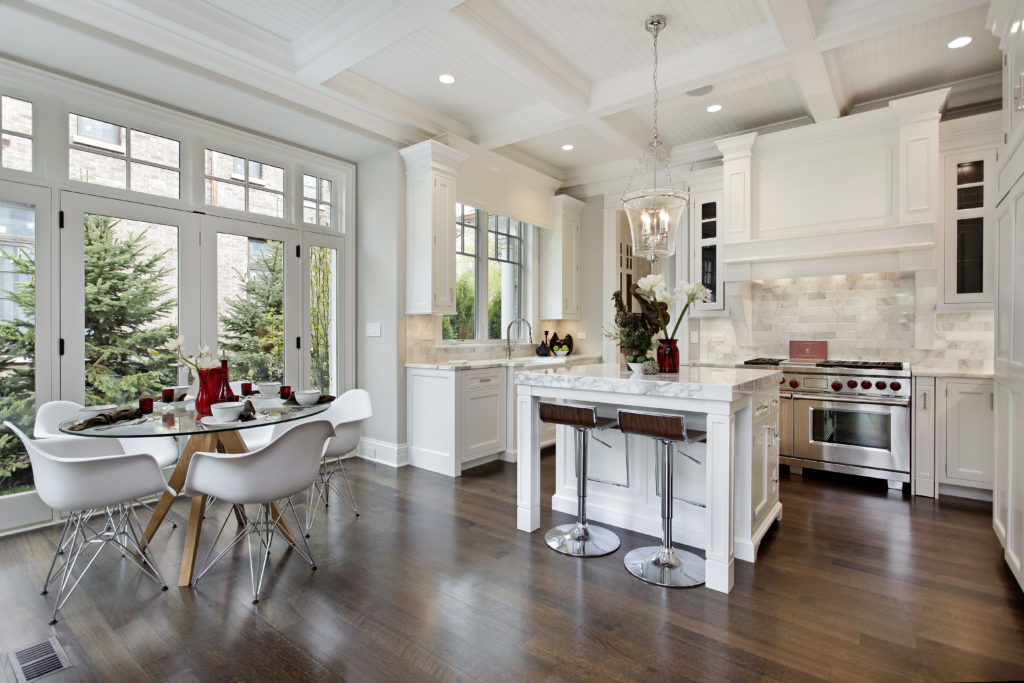
You read that right. You can install solid hardwood in your kitchen.
Is it the easiest or most convenient option? Ehh.
But: if you’re very careful and maintain it regularly, solid hardwood flooring in your kitchen isn’t much different from having a wood floor bathroom. Plus, there are plenty of coatings that can turn ordinary solid hardwood floors into (relatively) water-resistant wood flooring.
Solid (e.g. not engineered) hardwood is gorgeous and timeless. The best hardwood floor brands make products that last seemingly forever when maintained properly. You just need to know where to look!
Going back to our good-flooring-for-dogs-is-good-flooring-for-kitchens analogy, you’ll find that the best wood flooring for dogs can do well as kitchen flooring too.
Pros of Using Solid Hardwood as Kitchen Flooring
There’s so much you can do with hardwood. From wide-plank wood flooring to parquet flooring, solid hardwood offers no shortage of beautiful design options.
Many hardwood species used for flooring, like hickory or oak, also have some degree of natural water resistance (meaning a spill isn’t lethal so long as you clean it quickly). However, many softwood floors like Douglas fir flooring (which happens to be sustainable wood flooring, by the way) also have good water resistance, making them decent options for kitchen flooring as well.
Cons of Using Solid Hardwood as Kitchen Flooring
And here’s where things get dicey. If you like to cook, your kitchen flooring needs to be able to handle the daily rigors that come with it. Spills, heavy foot traffic, temperature swings, and more all have an effect on your flooring.
To counter this, you need to maintain solid hardwood kitchen flooring very well—and you’ll probably need to refinish and/or repair it more frequently than if it were in your living room.
Oh, and the cost to refinish hardwood flooring isn’t exactly cheap…which brings us to our next point: buying a hardwood floor is expensive. Even the cost of oak flooring, a popular and widely available domestic hardwood, can easily double that of top-of-the-line LVP or laminate.
And one last thing, hardwood is far from the easiest flooring to install—especially super tough products like (rare) ebony flooring. Unless you’re a DIY pro, we strongly recommend hiring someone to install hardwood kitchen flooring.
#9. Bamboo
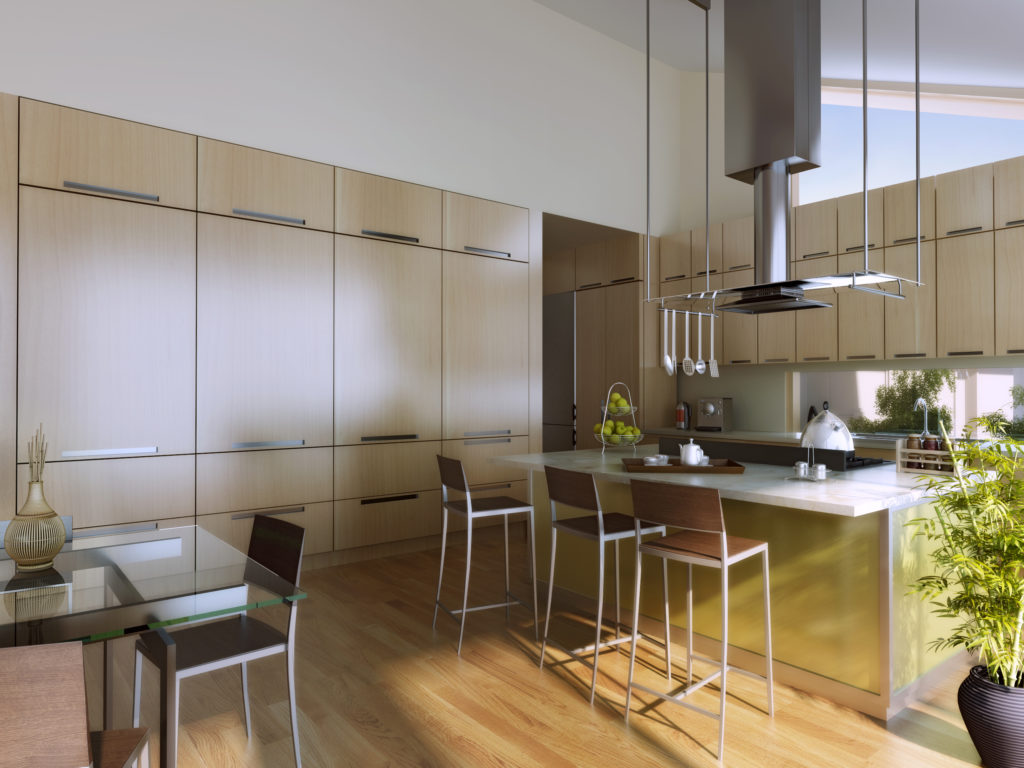
The best bamboo flooring is definitely in the same category as solid hardwood. You can install it in your kitchen, but you still need to be careful with liquids and environmental changes.
Otherwise, bamboo is a great alternative to hardwood because it can achieve many of the same looks with a softer hit on the environment.
Engineered options handle these stressors better than solid bamboo products (the pros and cons of engineered bamboo flooring are very similar to those of engineered hardwood, by the way).
Pros of Using Bamboo as Kitchen Flooring
The main reason buyers choose bamboo flooring over hardwood is because it’s the more environmentally friendly flooring choice (at least on paper). Bamboo flooring behaves very similarly to hardwood, but it can be harvested every few years versus every few decades—which also means it’s mostly, if not completely, natural (one reason some prefer bamboo flooring vs. laminate or other synthetic floors).
Cons of Using Bamboo as Kitchen Flooring
Like hardwood, you need to clean, maintain, and even refinish bamboo flooring regularly. Unlike hardwood, bamboo flooring isn’t abundant. So it’s not exactly cheap.
Beyond that, bamboo is a solid choice for kitchen flooring.
#10. Linoleum
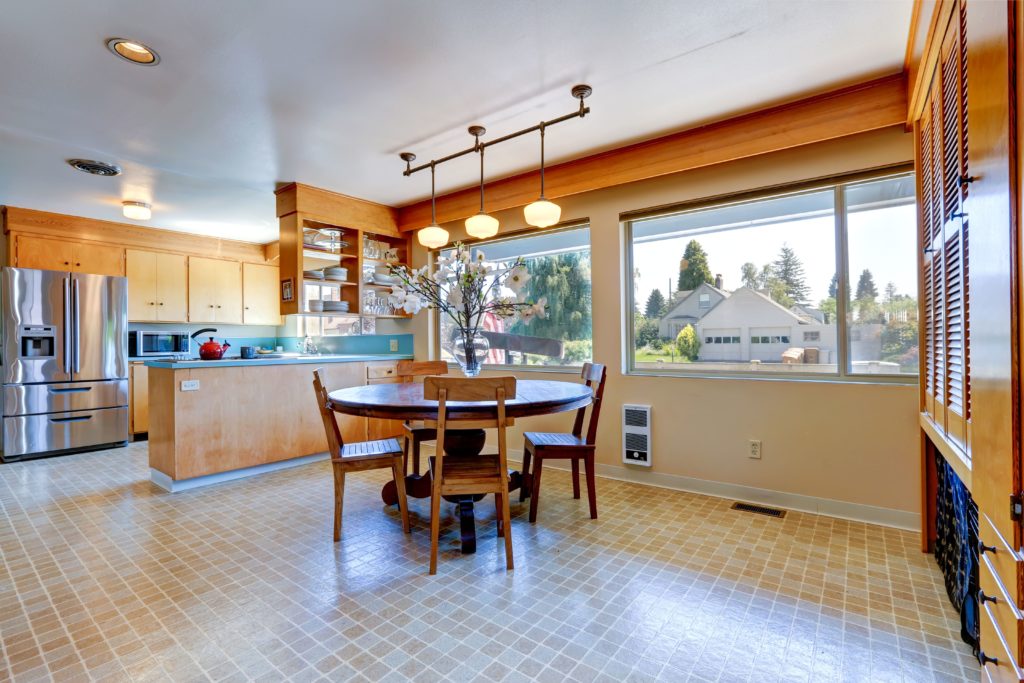
And finally, we arrive at our last candidate for the best kitchen flooring crown: linoleum.
Made from (mostly) natural materials, linoleum is sometimes compared to laminate as a sort of nemesis, and is often confused with sheet vinyl because they look and feel relatively similar.
But: if you compare linoleum vs. laminate, you’ll find the two composite products are structured entirely differently. And unlike sheet vinyl, linoleum is made from linseed oil, various resins, and natural fillers, while sheet vinyl is made from plastic.
Translation: while linoleum isn’t entirely water-resistant (without the proper coatings), it is eco-friendly. Linoleum is also one of the oldest flooring options around, having been invented in the early 1900s.
Pros of Using Linoleum as Kitchen Flooring
Linoleum’s best features sound a lot like vinyl’s: it can mimic other floors, it’s durable, and it’s affordable.
Unlike synthetic flooring though, linoleum is biodegradable and can be produced sustainably. Plus, you can seal it (much like cork) to improve its water resistance. And bonus: it’s soft underfoot.
Modern options like Forbo’s Marmoleum can even be installed in a floating style (though, this particular product is only available in Australia at the moment).
Cons of Using Linoleum as Kitchen Flooring
The fact that linoleum isn’t water-resistant without being sealed means that whatever money you’re saving on its cost is going towards extra installation steps. And installing linoleum without that protection may result in ruined kitchen flooring. This protection may negatively affect linoleum’s eco-friendliness too.
More than that, linoleum is getting harder to find (currently, at least). The popularity of other types of floors has forced linoleum to the backburner, and in doing so, has limited the number of styles available.
Best Flooring for Kitchens: The FAQs
Now that we’ve gone through our favorite options for the best kitchen flooring, let’s cover a few important FAQs.
What’s the Most Durable Kitchen Flooring?
Technically, concrete is the most durable kitchen flooring. Unless you take a jackhammer to it or your foundation crumbles, there’s not much that will break it.
LVP is a great runner-up that offers a lot more style options, however.
Can You Install Kitchen Flooring in a Floating Style?
Absolutely!
Though you should be aware that one of the disadvantages of floating floors is that they have to be installed perfectly for their liquid protection to work properly, which is important if you want the best flooring for a kitchen—and this can be difficult for floating floors like loose lay vinyl plank flooring.
Sidenote: check out our guide if you don’t know what a floating floor is.
Should I Choose DIY Or a Professional Flooring Installation?
There are a lot of factors at work here, including your contractor’s skills, the type of flooring you’ve chosen, whether you’ll void your floor’s warranty, and the state of your kitchen’s subflooring.
In terms of ability, certain floors are much harder to install than others. DIY wood floors, for example, are incredibly difficult to install without tons of experience—if you don’t already know how to install hardwood floors, you’re taking a really big risk.
On the fake wood front, floating vinyl plank flooring is a bit easier to install versus glue-down vinyl plank flooring because you’re clicking planks together instead of carefully gluing each plank down (the same goes for their laminate counterparts).
It’s also worth knowing that many companies void their product’s warranty if you choose the DIY flooring route. Improper installation can ruin flooring, so some companies try to discourage DIY in favor of professional installations.
Finally, if your subflooring is anything less than perfect, you’ll either need to repair it or find a floor that can accommodate whatever blemish is present.
Overall: DIY is great if you have the skills, but we generally recommend hiring a professional team to preserve your warranty (if applicable) and ensure proper installation.
What Is the Easiest Kitchen Floor to Keep Clean?
LVP is the easiest kitchen flooring to clean and maintain. Its stain resistance is top notch and most products can be mopped. Obviously, concrete is also easy to clean, but it can also be stained (accidentally) by certain foods—and obviously, the best kitchen flooring should be relatively stain-resistant.
Is Vinyl Plank Flooring Actually Good for Kitchens?
Unquestionably.
High-quality LVP like Proximity Mills or Pergo Extreme (check out our Pergo Extreme reviews) is arguably the best flooring for a kitchen, or at least, it’s the best all-around flooring for kitchens. It’s easy to clean, fully waterproof, durable, and should last at least a few decades with normal upkeep.
Is It a Good Idea to Put Laminate Flooring in a Kitchen?
Most laminate isn’t waterproof like LVP is, but there are a few products that actually stack up well (our vinyl plank vs. laminate guide is a good place to see all the differences).
We mentioned Mohawk’s RevWood and AquaGuard laminate earlier; both are good kitchen flooring options.
We wouldn’t recommend any laminate that isn’t at least water-resistant, though.
Can Kitchen Flooring Go Under Cabinets?
It depends. But, this may be an unnecessary step unless you’re installing cabinets at a later date.
Surfaces like concrete and tile can support cabinets and appliances; but while good hardwood, laminate, and LVP can go anywhere indoors (you can even put vinyl plank flooring on stairs), they’re often not meant to bear that amount of weight for that amount of time. That’s not to say that you can’t put cabinets on top of your kitchen flooring—you just need to find out what your floors can take.
For this, we’d recommend talking to your floor’s manufacturer!
What’s Trending In Kitchen Flooring?
Oddly enough, different types of wood flooring are starting to pop up in kitchens as engineered wood and protective coatings become more robust. LVP and tile are also timeless options.
What’s the Most Popular Flooring for Kitchens?
Fake wood flooring like vinyl plank and classic choices like tile are easily the most popular options for kitchen flooring. Their performance in wet environments is hard to displace.
Are There Any Recommended Flooring Companies for Kitchens?
Not necessarily! However, we do recommend choosing local flooring stores over big box stores as their products tend to be better and you’ll get expert advice and opinions.
That’s not to say that decent big box store products like Lowes’ SmartCore flooring or Home Depot’s LifeProof vinyl flooring are bad by any means, but you can often find similarly priced, yet better products at local stores.
How Much Does it Cost to Replace Kitchen Flooring?
If you know how to replace flooring, then you probably know it’s not cheap.
Snap-together flooring products are the easiest to replace, so they also tend to be the cheapest to remove, but anything labor-intensive (glued, nailed, or stapled floors) is going to cost more.
As for specific numbers, it’ll likely depend on where you live, the type of flooring you’re removing, any relevant disposal fees (synthetic hardwood floor alternatives can sometimes cost more), and then, the cost to buy and install your new flooring, of course.
Don’t expect anything less than a couple thousand dollars for your average room.
What Should I Put on My Kitchen Flooring?
On the one hand, you can put whatever you like on your kitchen flooring. However, we do have some recommendations:
- Anything that will make your floors slick is a bad idea, especially if you cook often. You don’t want to slip on your way to the oven or sink!
- Kitchen mats are popular for a reason. Adding non-slip surfaces to floors that are otherwise slick can be a great investment in your health! The best flooring for kitchens is the safest flooring for kitchens.
What’s the Best Flooring for a Kitchen and Living Room Combo?
Vinyl plank and waterproof laminate are the best flooring options here because they balance comfort and performance well.
You won’t have to worry about spills and a classy hardwood style is always a good look.
What’s the Best Flooring for a Small Kitchen?
The type of kitchen flooring shouldn’t matter too much. But it might be nice to choose an option with wider planks or tiles, which can make a small space feel larger.
What’s the Best Flooring for High-Traffic Kitchens?
Once again, the best vinyl flooring is the winner here. However, the most durable wood flooring and tile are good runners-up for high-traffic kitchen flooring. Concrete is supremely durable, but it loses points for its lack of comfort. You really don’t want to run around on concrete all day.
Conclusion: What Is the Best Flooring for a Kitchen?
The best flooring for a kitchen often comes down to how you plan on using your kitchen.
Vinyl plank scores high marks across the board but buyers who don’t mind regular maintenance may prefer engineered or solid hardwood for their authenticity. Still, others may prefer tile as the traditional option; tile flooring is practically synonymous with the best kitchen flooring.
That said, cork, concrete, linoleum, laminate, and sheet vinyl all have something to offer too.
How to Choose the Best Kitchen Flooring for You (Hint: Try Your Local Flooring Store)
If you can’t decide which type of kitchen flooring makes the most sense for your situation, try your local top-rated flooring stores for advice. Seriously. Not only do they hire true flooring experts and installers (versus run-of-the-mill contractors), they’ll offer the best deals.
Or, if you’re still pregaming with some research, why not check out the articles below!
- Your Guide to Light Wood Flooring
- Choosing Wood Floor Colors: The 2022 Guide
- Pergo Outlast Reviews: Is Home Depot’s Pergo Any Good?
- Tile vs. Laminate Flooring: The Pros and Cons
- Outdoor Vinyl Flooring: Guide & Brands
- NuCore Flooring Reviews: Is It Worth It?
- Magnetic Flooring: Everything You Need to Know
- The Ultimate Guide to Low-VOC Carpet
- Hemp Flooring: Your Complete Guide to Hemp Wood
- Carpet or Hardwood in Bedrooms: Which is Better?
- 15 Beautiful and Affordable Outdoor Flooring Options
- How Much Does it Cost to Replace Carpet With Hardwood?
- 9 Reasons The “Carpet vs. Hardwood” Debate is Silly
- Carpet vs. Laminate: The *Real* Pros & Cons
- A Guide to Peel-and-Stick Carpet Tiles (& 9 Reasons They’re Amazing)
- The Ultimate Guide to Low-VOC Flooring
About The Author

Christian Southards
December 14, 2021
Christian is a freelance everything-writer, editor, and interior design nerd. When he’s not writing about flooring and remodeling, he’s either writing news for the California American Legion or working with his hands on his house. His favorite type of flooring is hardwood, but admits to having carpet in his bedroom.






